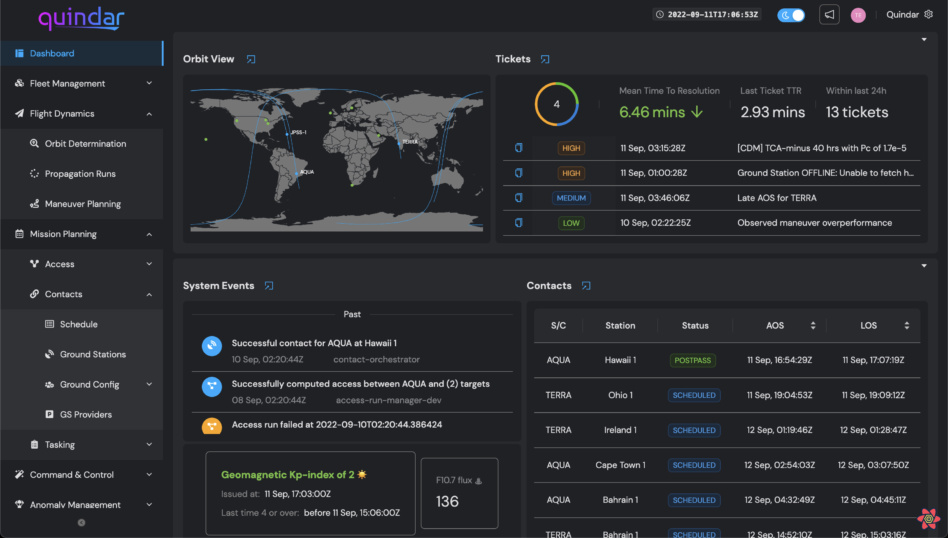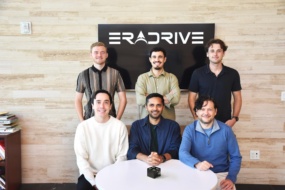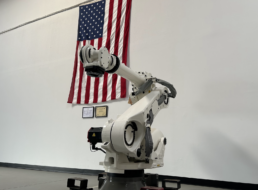Quindar aims to become the complete web application for satellite constellation mission analysis, testing, and operations.
The Denver-based startup recently graduated from Y Combinator. Quindar’s six technical co-founders—yes, six, and all technical—believe satellite operations should look more like elegant, modern software stacks. The platform, if successful, could cut traditional dependencies on engineers, IT teams, and operations positions.
Pain points
Quindar’s founders met while working at OneWeb, where they struggled with the very satellite mission management issues the startup aims to solve such as fragmented solutions, non-scalable bespoke answers, and lacking security standards. They found too many engineers were needlessly architecting, building, operating, and maintaining processes whose first principles have not changed since the 1960’s.
Going through Y Combinator helped Quindar’s co-founders build out their product, hone the pitch, and engage with customers at the same time.
Payload caught up with CEO and Co-founder Nate Hamet, who has been in the aerospace industry for eight years. Prior to his current startup, Hamet has done stints at Lockheed Martin, OneWeb, and Orbital Effects.
Note: This interview was edited for clarity and length.
The Conversation
YC’s Demo Day was last week. How has the summer panned out for Quindar?
Summer at YC has pushed us further into our customer engagement journey than we could have imagined. The team’s experience shows we can build this solution, but more importantly, by closely working with our customers and partners, we are focused on ‘HOW’ do we build mission management as a service to seamlessly integrate with their constellation.
We have received a lot of good traction given the two months since we launched, and we’re excited to announce some of that soon.
Could you tell us a bit about the problem you saw that led to the creation of Quindar?
When we were doing make-buy trades for solutions to operate satellites, there was never a solution that was the complete operations platform. You had to integrate a flight dynamics solution with a mission planning solution with a command and control solution. Then, create the middleware for all of that. The next thing you know, we were managing and maintaining a software team when we wanted to get into aerospace operations. So that doesn’t necessarily scale with constellations and involves a lot of overhead. The solutions that we were creating in house to adapt to the operations at hand contained more software than the actual software that we were purchasing.
Prospects that we talk to today bring up the same pain points. It’s kind of ironic that we’re talking to each other during those prospecting meetings, because they’re still in search of that solution that we’re trying to deliver.
We also saw a segmented test environment vs. the actual production environment. One team would build the satellites and test them, and then throw it over the fence and say: “here’s what we did, make it work in operations.” And you have to reinvent a very similar wheel. So, there needed to be more synergy between the actual building and testing of the satellites and the operations.
What made your team think you could solve it?
We have six co-founders in total, all technical. All of us actually started together, almost in the same week, at OneWeb. We’ve been together for six or seven years now, have operated two constellations, and designed for a mega-constellation. We have a great technical team with diverse soft and hard skills, including cybersecurity, software, cloud architect, AI/ML, networks, program management, and flight dynamics.
So beyond us living in the organic problem itself and creating some solutions to it, our skills complement each other very, very well. Our skills very much complemented each other and then some of us have been managers while some of us have been just technical developers. So we have kind of the full circle.
Can you walk us through the platform?
Quindar is a web app that satellite operators can utilize to analyze their mission. They can create their mission configuration, [based off of]:
- What do their spacecraft look like?
- How many do they have?
- What orbital planes are they going to be in?
- What are the communication bands on the satellite itself?
We can select the right ground station providers and filter out the ones that don’t work so that they can start working on their licensing and other long lead items. Then there is the command and control side. All of that is in the same web app, same platform integrated together, so that even when issues do arise in the ground infrastructure, in the antenna arena, or within the spacecraft itself, all of those events are aggregated and fed back into the system so that we can replan if something occurred on the satellite. If we couldn’t actually complete the tasks at hand, we can replan those tasks for the next pass and analyze issues that actually happen.
But also, it is adaptable for different orbital regimes too. LEO is growing, but people are trying to get into cislunar and to lunar and beyond GEO. We want to support all of them with the same platform.
It starts from the mission concept, the design. So you say: “Okay, I want to beam [the] internet down from space. How many satellites is that going to take?” You could start putting in those satellites, where your antenna locations are, and work with the actual conceptual part as you go into operations as well as testing.
What led to the ‘All right, we’re gonna do this” moment?
It definitely took a step of bravery just to say, “Hey, let’s quit our jobs and go start our own company where we have no idea what the outcome could be or the challenges that lie ahead.”
As we started to see the market shift, including these mega-constellation announcements, we put ourselves in their shoes and said: “Oh, no, they’re going to hit the exact same problems that we had, and they’ll have to scale up their software teams.” I don’t see these commercial providers providing those solutions.
We want this technology to be available to myself, my family, my friends, or colleagues. I think it was within the last year when people started to come out with more of those mega-constellation announcements, and the solution still hadn’t evolved. We have to actually do this ourselves, or no one else might do it.
What is your mission and what motivates you?
It’s honestly to democratize space and make it more accessible. Lower launch costs and smaller vehicles definitely help get to space. Ground stations as a service further lower barriers, making it easy to rent time on modern cloud platforms without going through some of the back channels for sales and integrations.
With cubesats and other satellites that you can actually buy from manufacturers now and just slap your payload on, there’s still the midstream that’s missing. This is the actual “how do you operate this.” Similar to how there’s terrestrial IT for computers, there also needs to be space IT for satellites. Operations haven’t changed or evolved in decades. Lowering barriers and misunderstandings of space can lead the way for breakthrough technologies for those without ten years of aerospace experience
We love a Y combinator space company. What led you to apply?
The reason we applied to YC is we found ourselves already walking through the YC playbook when we incorporated. We’re six technical co-founders who had never stood up a business but thought we had a solution based on our organic problems. We also have a really good network.
We thought we had a good start, but we had some misconceptions around starting a company. For example, not inputting your bias of what your solution is, but actually talking to users by asking:
- What are their pain points with their current solutions?
- How often does it occur?
- What do they currently do?
We found ourselves using their resources and working our way through their startup school, and said: ‘Why not apply?’ We definitely doubted ourselves going into it, because we applied without traction and more as a team with an idea.
And then when we got the call, which I still remember to today, they said, “We don’t normally fund six co-founder teams, but we’re making an exception based on what you’ve done in the past and the vision that you have.”
Lessons learned are a big part of our culture. We wanted to see how other startups had failed and to not do that. They’ve been phenomenal at keeping us focused when we would ask maybe silly questions. YC also aligned us to what we need to do: to find a product that people love, which sounds more simple than it is.
What stage are you at with product development?
We are iterating on our product, with the pain points especially in mind. The product itself has a lot of components, from the testing and mission analysis to flight dynamics, mission planning, command, control, and incident management. We’re starting upstream and asking: “what are the test tools that customers need to use today to design their constellations?” We’ve started to release blogs that lead our customers into understanding that mission management is more than just spacecraft operations.
We started to create more of the flight dynamics mission analysis tools that we would need to understand, from the number of satellites needed to optimal ground station locations. We are talking to design partners and customers, then working towards actually scheduling against multiple ground station providers and making a single interface where a customer can say: “I want 10 contacts a day, spread out over the day evenly, please make that happen.” Or, “one got canceled, please reschedule it.”
Currently, we’re working on the command and control side, and being able to actually test satellites on the floor before getting into operations, with the same platform and same familiarity as you would use an ops without having to be retrained.
This is what YC helped with, too. Initially, we thought we’d need to spend eight months building out the product, then launch, and onboard people onto a product they can fully use. YC’s advice was to launch frequently and often. We’re going to always be launching as the company grows and adapts. So, we launched our product and have been getting some good input. But that’s why we’re also focusing on the mission analysis, because that and test are what people need today, not necessarily operations.
What makes you different from other mission management software?
One of our competitive advantages is security. With the recent Ukraine-Russia conflict and attacks on the satcom industry, creating a solution that is secure is our #1 focus. Security is one of our big differentiators. We want to be able to handle US commercial and government traffic within our platform.
Another differentiator is scalability. It’s rare to find a team that can help design a system that currently operates a megaconstellation. We definitely understand where scale works, and where it doesn’t.
Adaptability for multiple missions is another strength. The LEO market is booming, but so are other orbits. We want to support them with the same platform and Quindar solution.
Increased situational awareness isn’t a software solution where you throw it over the fence to a whole new team and say: “make this work and fly the mission, we just want the data.” Some of our current prospects want to handle their mission themselves. Being able to not have to manage the infrastructure or software but still have complete control of your mission is where we’re a differentiator.
Finally, I’d say the last thing that makes us different is our partnerships and integrations. We’re partnering with ground station providers, higher-fidelity flight dynamics operators, command and control product developers, and mission analysis operators to give you higher resolution and input into the system. It’s very API-rich. Anything that you can see in the web application itself, you can extract via API, run your own analysis, and create your own tools, if that’s what you wish.
Five years from now, we’re in a world where everyone is using your product. What does the space industry look like?
We should have more operations on the satellite. Today, the satellites don’t do enough and need to be more like IoT devices, beaming down info about what needs to happen, not relying on the ground to tell them what needs to happen. So, more needs to happen in the sky with higher processing and computing going on-board the satellite.
Companies are going to have dozens of satellites on average each. Security will be done in the cloud, vs. physical buildings, and you’ll need more cloud resources on the ground. We should be on the Moon five years from now, and Quindar wants to be a part of that.
The other industry shift was Covid, which showcased that you could operate a mission—like JPL did—from your house. Finding talent is already hard enough as it is in today’s market. Being able to reach remote talent is a shift we’re already seeing. Being able to control and manage satellites from your home securely is where the industry is headed as well.
What does the next six months look like for Quindar?
Onboarding more customers. We hope to have a few customers by the end of 2023, or even this year, who are actively using the product. And since Quindar is more operator-centric, we’re automating out the actual operations themselves. We can actually utilize the spacecraft manual to understand what an operator would do in a specific situation, read the spacecraft manual, figure out the corrective action, identify the procedure to run, find the person that actually expects the procedure to be executed, and do this automatically based off of all of the analytics and metrics that we’ve gathered today.
We haven’t looked into fundraising just yet, since we’re focused on the product and customers.
What are you most excited about in the industry today?
More companies are entering the arena. The commercial EO, ISS, and PNT markets are fascinating. More government services are being outsourced commercially, which brings us quick, modern, and cost-effective solutions.
These are brand new startups building solutions to these organic issues that people have experienced at other companies. The number of new space companies makes space super exciting to be a part of. By talking to customers as well, we’re learning about all these unique missions that haven’t been done in the past.
It is exciting to see the government-to-commercial handoff, because the commercial side moves so quick. Especially startups. It’s exciting to see the SpaceX-esque mentality of ‘getting things done quickly’ be embraced with modern technology.




